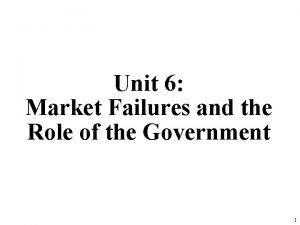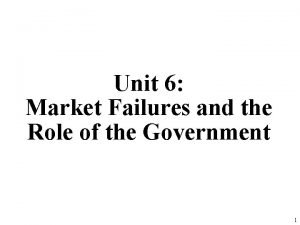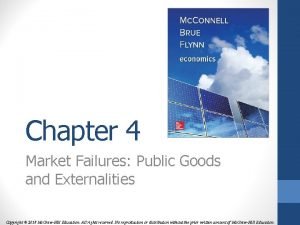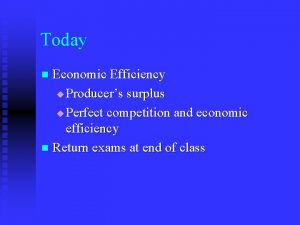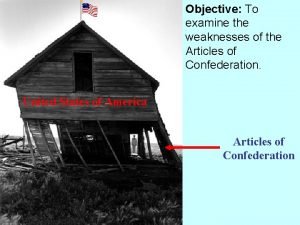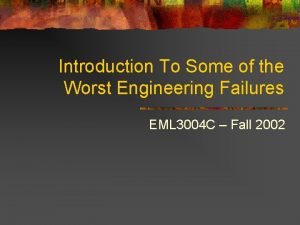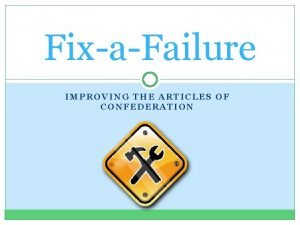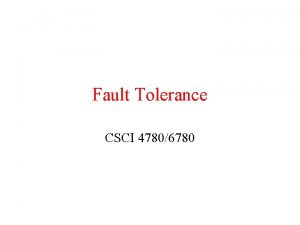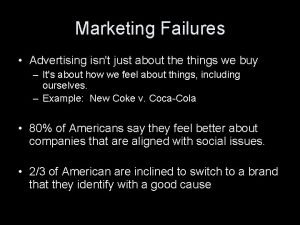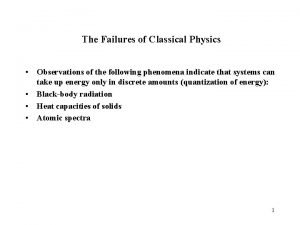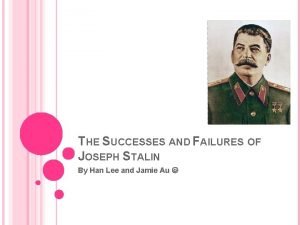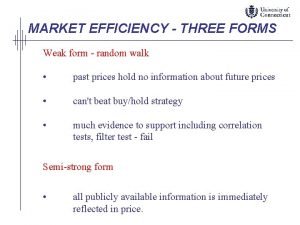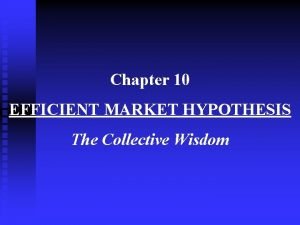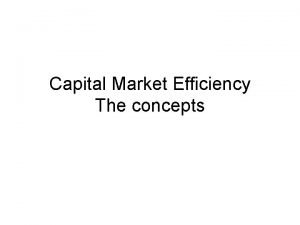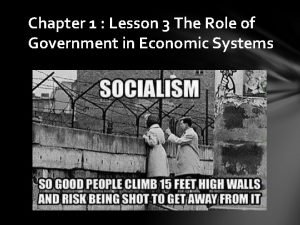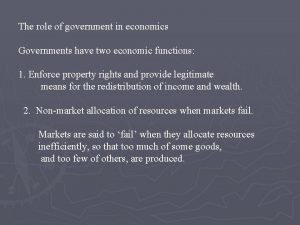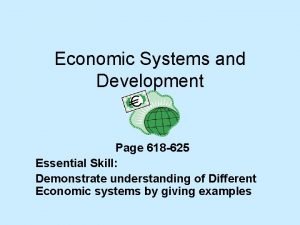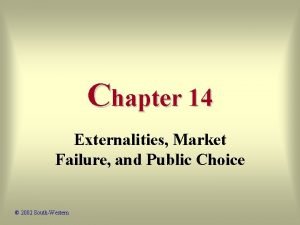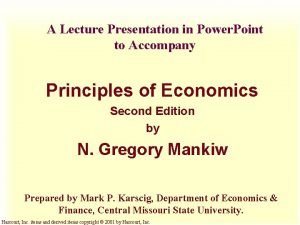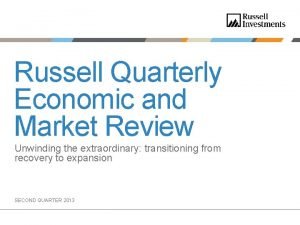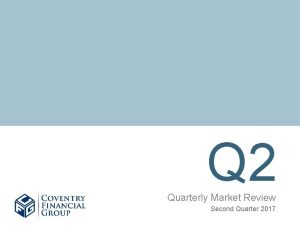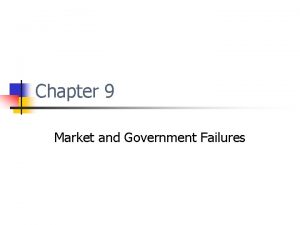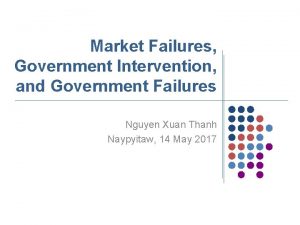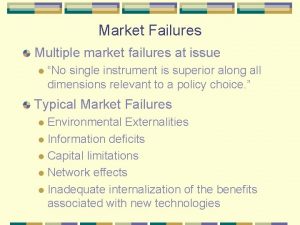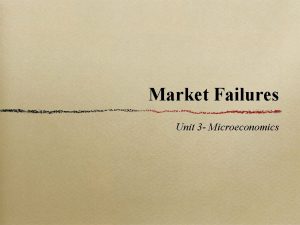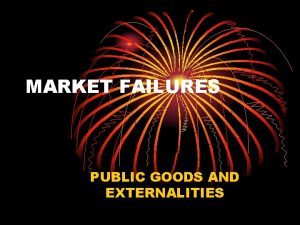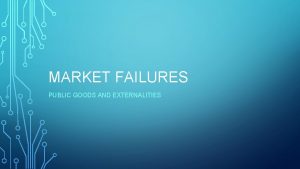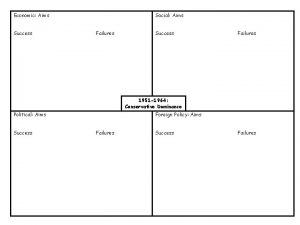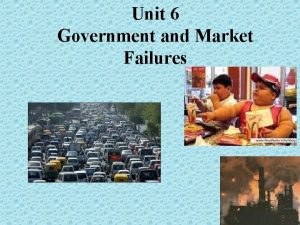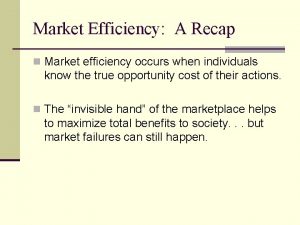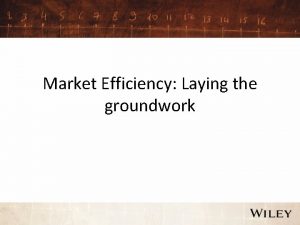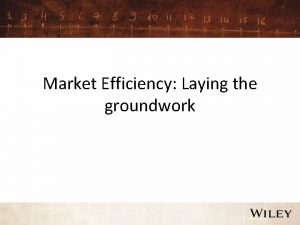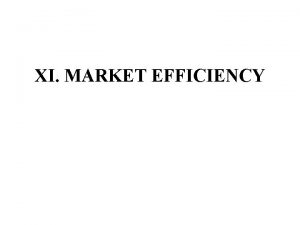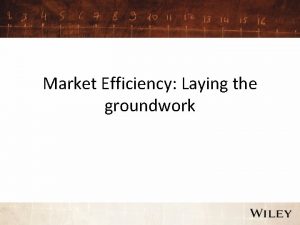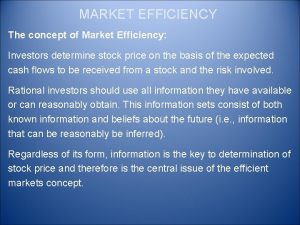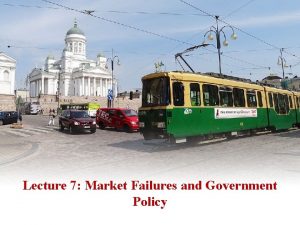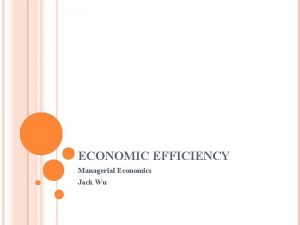LECTURE 6 7 ECONOMIC EFFICIENCY MARKET FAILURES GOVERNMENT











































- Slides: 43

LECTURE 6 & 7 ECONOMIC EFFICIENCY, MARKET FAILURES & GOVERNMENT INTERVENTION 0

§ EFFICIENT ALLOCATION OF RESOURCES: § Perfect market Versus Real market § MAJOR SOURCES OF MARKET FAILURE: § Externalities § Public Goods § Imperfect Information § GOVERNMENT INTERVENTION 1

PERFECT COMPETITION VS. REAL MARKETS? Perfectly competitive market is a system that produces an efficient allocation of resources. Assumption: Households are price takers (P=MR = AR) Perfect information All firms maximize profit (P = MC = MR) Equilibrium at the point where P = MC Does these asummptions holds in real market? No, why? P > MC 2

Market Failure & Efficiency • Fig 1 A case of Market Failure • Fig 2 Freely competitive Market. No failure 3

A Perfectly Free Market is a rarity • Many small businesses operate under conditions of monopolistic competition, including independently owned and operated stores and restaurants • Allocative inefficiency is therefore the norms • And a freely competitive market is the exception • Market as in Fig 1 is the norm 4

DWL • The cost to society of inefficiency is called Dead Weight Loss (DWL) • It is the loss of total welfare • Possible causes: taxes, externalities, monopoly pricing. 5

Living With Market Failures • Market failure occurs when resources are misallocated or allocated inefficiently. • Various sources of market failure: • Three major ones o Externalities o Public Goods o Imperfect Information 6

MARKET FAILURE EXTERNALITIES 7

8

EXTERNALITIES Externalities are benefits or costs that effects someone who is not directly involved in the production or consumption of g/s OR Externalities are unintentional side effects of an economic activity Negative vs. Positive Externalities 9

THE BASIC CONCEPT Private Cost The cost borne by the producer of the g/s Private Benefit The benefit received by the consumer from a consumption of g/s Social Cost The total cost of producing g/s, including private cost and other external cost (cost to pollute) Social Benefit The total benefit from consuming g/s, including private benefit + any external benefit 10

MARGINAL COSTS AND BENEFITS Marginal Social Cost (MSC) = Marginal Private cost (MPC) + Marginal External Cost (MEC) MSC = MPC + MEC Marginal Social Benefit = Marginal Private Benefit (MPB) + Marginal External Benefit (MEB) MSB = MPB + MEB In the sum we have now taken accounts of all the factors into the market place. 11

NEGATIVE EXTERNALITIES A negative externality is a side effect that can be harmful to society or the environment: haze; plastic waste; toxic dump • Pollution may pose health risk or degrade air quality or water. • The owner of factories does not directly pay the additional cost of cleaning up. 12

Figure 1. 1: Pollution and Negative Externalities Before Externalities Price of Alum. S 1 (MSC) S 0 (MPC) The equilibrium; E 1 (QMKT) MPC = MPB S 0 = Marginal Private Cost External costs E 2 DWL D = Marginal Private Benefit At QMKT, there is DWL. E 1 After Externalities D 0 (private value) 0 E 2 (QOPT) MSC = MSB S 1 = MSC = MPC + MEC (Shift in Social Cost curve) QOPT QMKT Quantity QMKT > QOPT Externalities leads to a social welfare loss Over production/allocation of resources and output 13

SOLVING THE NEGATIVE EXTERNALITIES To achieve the socially optimal output… • The government can reduce the externality effects by imposing tax on the producer to reduce the equilibrium quantity to the socially desirable quantity • This is also known as, “ making the polluter pay” • A tax increases the private cost on production causing a fall in output (Figure 1. 1: S 0 shifts to S 1 ) 14

POSITIVE EXTERNALITIES Good side effect which affected a third party who indirectly involved in the transaction The result of the social benefit of production/consumption is greater than the private benefit • Lower cost for other parties • Increased revenues/profits for other parties • Increased satisfaction for other parties 15

EXAMPLES OF POSITIVE EXTERNALITY Education: 1. The development of new knowledge (the research function) 2. The training qualified personnel (the teaching function) 3. The provision of services to society 4. The supply of literate society MPB: You too benefitted personally from education. Cycling to work: MPB: Health benefits of cycling MEB: Help to reduce traffic congestion. 16

Figure 1. 2: Education and the Social Optimum Before Externalities Price of Edu. The equilibrium; S (MPC) E 1 (QMKT) MPC = MPB S = Marginal Private Cost E 2 DWL D 0 = Marginal Private Benefit At QMKT, there is DWL. E 1 After Externalities D 1 (MSB) 0 D 0 (private value) QMKT QOPT Quantity E 2 (QOPT) MSC = MSB D 1 = MSB = MPB + MEB (Shift in Social Benefit curve) QMKT < QOPT Externalities leads to an increase in social benefit. Under production/allocation of resources and output 17

SOLVING THE POSITIVE EXTERNALITIES To achieve the socially optimal output… • The government may increase the consumption on education by giving subsidies to the producer/consumer. • When there is subsidy, it reduces the private cost on production/consumption causing the expansion of demand towards the optimal point Ø Demand Effect: D 0 shifts to D 1 : an incentive to buyers. Ø Supply Effect: If subsidy reduces costs, SS curve shifts rightwards (Supply Effect): an incentive to suppliers. 18

MARKET FAILURE PUBLIC GOODS 19

CHARACTERISTICS OF PUBLIC GOODS • A public good has two characteristics: - If it has been provided to one consumer it is difficult/ impossible to stop another from enjoying it too. “Non-Excludable” - The amount of the good I enjoy has no affect on the amount you enjoy. “Non-rival” 20

Public Goods • There is a category of goods where the free market may not produce at all • These are goods where we have no choice but to share and to allow others to enjoy them too ü (non-excludable and non-rival) If efforts to clean-up polluted rivers is successful you can’t prevent others from enjoying the clean waterways; can you? 21

PG • PG can be enjoyed by more than one person and those enjoying cannot prevent others from receiving the benefits • TV and radio signals; open source software • Disease control • Clean air and Pollution abatements ü Pollution: Bad news is the “free-riders” people who try to benefit from the clean up without pitching in It is the non-exclusivity element that leads to free-riding 22

Quasi-public goods • Quasi-public goods are often referred to as Common Resource goods • They are rival goods but not excludable ü One person’s use of a common resource diminishes the amount available for others: § Severe depletion of fish stocks § Deforestations ü In each case, a resource that is freely available is overused 23

OVERUSE OF A COMMON RESOURCES If each logger cuts to his private needs and ignoring all others, the total volume taken would be Q 1. Efficient equilibrium Q 2 is the socially acceptable quantity if the social costs and preference are accounted for. The loss to society is shaded yellow. 24

• The problem with PQ is free riding: individuals know they can benefit without paying for it ü Under-provisioning results when public goods are supplied by a free market; ü And in common resources: overuse ü How are these relevant to environmental economics? ü Climate change ü Clean air ü The forests ü Ocean fish ü Floods 25

• What can be done? ücase for government intervention with public goods § Overcoming the Free-Rider problem § Overcoming under-provisioning and underconsumption of public goods 26

Govt. case • If the government provides public goods they may be able to do so more efficiently because of economies of scale • "The truth is that markets cannot exist without governments, and vice versa. Governments are essential to the establishment of security, justice, property rights, and contract enforcement, all of which are essential to a market economy. " 27

TYPES OF GOODS 28

PRIVATE GOODS • A product that must be purchased in order to be consumed, and whose consumption by one individual prevents another individual from consuming it. • (Rival & Excludable) • For example, a burger is excludable because it is possible to prevent someone from eating the burger. 29

NATURAL MONOPOLIES • Exists as a result of the high fixed or start-up costs of operating a business in a particular industry. • Example: Power generations supply • Why power generations been classified as natural monopoly goods? 30

Case study: Over fishing in South China Sea? Problems: ü South China Sea is over-fished by many countries ü Vast improvements in fishing technology means more fish will be caught ü Human Population factor ü 50 -mile exclusion zones to respective countries are porous 31

• Many contributing factors to overfishing ü Destructive practices: - Destructive seabed trawling -Use of fine meshed nets -indiscriminate catches -Poaching 32

• At current catch rate wild fish stocks will not last (estimated 74% depletion bet. 1972 and 1999) • Ban is made by Malaysia on trawler fishing ü An effective solution can be complicated unless made on multinational scales: v Multilateral tradable annual quotas? v Licensing? v Breeders? v Regulations? v Policing? ü Challenges: can it be applied in S. E. Asia waters? 33

PROPERTY RIGHTS • Foundation to the economics: The market fails to allocate resources efficiently when property rights are not wellestablished (ownership to property) Forest? Common Land? Ocean? Air? 34

TRAGEDY OF THE COMMONS • Common: a land/resources shared with everyone. • Open access: Everybody can use the resources without any charges. • Example: Pasture for cows to graze Clear cutting tress in rain forest Fishing in the ocean 35

CASE STUDY: FISHING FOR THE FUTURE • Over fishing in the South China Sea: Accessible to all ASEAN countries (Vietnam, Thailand, Malaysia, Cambodia etc. ) • The causes: The depletion of the fish stocks will affect other fishermen and loss of benefits. If no measures are taken to address the decline, fish stock is likely to be depleted by the year 2048 • What should the authorities do? ² Quota (Australia, Namibia had done this approach) ² Permit ² Closed-Accessed 36

MARKET FAILURE IMPERFECT INFORMATION 37

IMPERFECT INFORMATION ü Market fails when information received about a product is asymmetrical: (i. e different parties to a transaction have different levels of information) § Used car salesman and customer § Doctor and patient § Harm done by pollution § Sales of defective products 38

If no one realizes an activity is bad (e. g. Mercury poisoning in Onondaga Lake: 1950 s), imperfect information is not the problem. and If all sides have the same knowledge, even if uncertainty exists, imperfect information is not a problem 39

Why is it important? • Because society may have no clear information of the dangers: ü Health hazards from toxic wastes ü Harmful effects of pollution ü Resource depletions ü Global warming ü Etc. 40

What can be done? • Government can supply the information or regulate: ü If product seal is broken don’t sell/buy ü Product labeling ü Copyrights ü Fair ads regulation ü Insurance ü Publishing of financial returns ü Criminalizing substance abuse 41

THE END 42
 Unit 6 market failures and the role of the government
Unit 6 market failures and the role of the government Unit 6 four market failures
Unit 6 four market failures Chapter 7 section 1 guided reading
Chapter 7 section 1 guided reading Define market failure
Define market failure Demand-side market failures occur when
Demand-side market failures occur when Perfect/pure competition definition
Perfect/pure competition definition Market failures
Market failures Productive inefficiency and allocative inefficiency
Productive inefficiency and allocative inefficiency Allocative efficiency vs productive efficiency
Allocative efficiency vs productive efficiency Productively efficient vs allocatively efficient
Productively efficient vs allocatively efficient 01:640:244 lecture notes - lecture 15: plat, idah, farad
01:640:244 lecture notes - lecture 15: plat, idah, farad Market leader challenger follower nicher
Market leader challenger follower nicher Positioning targeting and segmentation
Positioning targeting and segmentation Economic efficiency
Economic efficiency Articles of confederation fail
Articles of confederation fail Engineering ethics failures
Engineering ethics failures Somatogravic illusion
Somatogravic illusion What are some failures of the articles of confederation?
What are some failures of the articles of confederation? Problems with the articles of confederation
Problems with the articles of confederation Rpc semantics in the presence of failures
Rpc semantics in the presence of failures Aneroid wafer
Aneroid wafer Cloud security failures
Cloud security failures Genghis khan
Genghis khan Advertising failures
Advertising failures Fixing service failures
Fixing service failures Failures of classical physics
Failures of classical physics 10 steps to equity in education
10 steps to equity in education Successes and failures of the five year plans
Successes and failures of the five year plans Structured data vs unstructured
Structured data vs unstructured Walk three forms
Walk three forms What is market efficiency
What is market efficiency What is market efficiency
What is market efficiency State and federal constitutions
State and federal constitutions Lesson 3 the role of government in economic systems
Lesson 3 the role of government in economic systems Economic role of government
Economic role of government Role of government in economic development
Role of government in economic development Economic growth vs economic development
Economic growth vs economic development Growth and development conclusion
Growth and development conclusion Economic systems lesson 2 our economic choices
Economic systems lesson 2 our economic choices Role of government in correcting market failure
Role of government in correcting market failure Governments can sometimes improve market outcomes examples
Governments can sometimes improve market outcomes examples Russell quarterly economic and market review
Russell quarterly economic and market review Yang fin
Yang fin Russell quarterly economic and market review
Russell quarterly economic and market review
